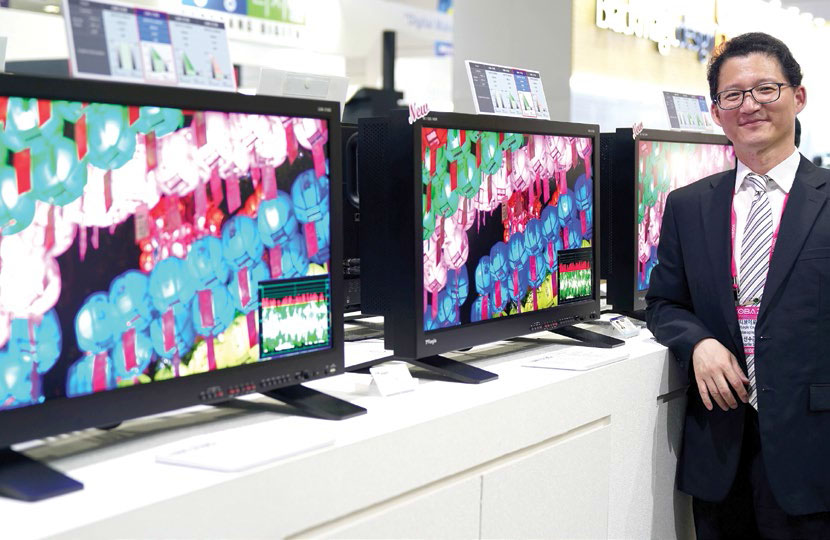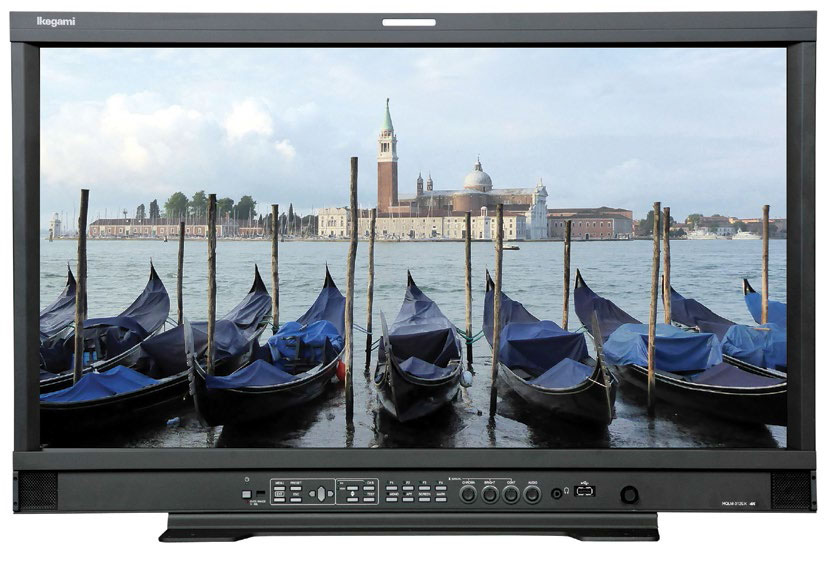Monitors Move Carefully Toward HDR
ALEXANDRIA, Va.—Any weak link in the video production chain will result in reduced quality images or sound, so continual improvement of each category of component is essential. For example, you won’t get all the benefit from better cameras if your monitors aren’t up to the task.

Now that high dynamic range (HDR) video is becoming a production reality, monitors need HDR capability to correctly show the contrast range of the images. In these early days of HDR products, there are different HDR standards and even different approaches to the underlying technology within the monitors themselves. Interestingly, manufacturers also approach UHD/4K and HD HDR displays differently.
“Around 2012, an international standard was created that defined Ultra High Definition formats, employing a much wider color gamut,” said Hugo Gaggioni, chief technology officer for Sony Imaging Products and Solutions America. “This standard was the ITU-R-BT.2020. State-of-the-art professional monitors can support around 80-85% of this color gamut. Therefore, HDR is not only about extensions in dynamic range but also the adoption of new color gamuts, which together give rise to new colors never before seen.”
Of course, in addition to a wider color gamut, HDR is about the range between black and white shades on the screen.
“The primary concern with HDR monitoring is how well the dynamic range is handled,” Gaggioni said. “The monitors must support the brightest highlights and deepest blacks—this is why exceptional contrast ratio capability is so important in HDR applications.”
Making this more complicated is that there are multiple standards for HDR, including standards that are semi-proprietary to manufacturers like Sony.
“Sony supports multiple formats: SMPTE ST.2084 [PQ], HLG [Hybrid Log Gamma], and Sony’s HDR production curves, such as S-Log3, S-Log2,” Gaggioni said. “Our HDR monitors must support all standardized HDR EOTF [Electrical-to-Optical Transfer Functions], but which ones are best for the job at hand depends upon the application.”
Get the TV Tech Newsletter
The professional video industry's #1 source for news, trends and product and tech information. Sign up below.
RANGE OF STANDARDS
Other manufacturers support their own range of HDR standards, and these may vary between UHD and HD displays.

Ikegami’s 4K monitors support HLG (BT.2100), PQ (ST.2084), and S-Log3 as well as HLG (BT.2100) and S-Log3 as options for its HD monitors, according to Alan Keil, vice president and director of engineering at Ikegami.
“For HDR, we are paying close attention to the reproduction in the blacks, as well as overall contrast and brightness,” he said. “We are looking for wide color gamut, as well as accurate LOG curve and color reproduction.”
Building an HDR display might seem a simple case of extending the capabilities of existing displays. But in reality, it turns out to be more difficult.
“Premium consumer TVs with HDR capability are using either LCD with local dimming backlight system or OLED screens,” said Charlie Shin, division leader and managing director for TVLogic Broadcast Equipment. “Neither of the two technologies reproduces HDR perfectly, but both are roughly accepted by consumers.
“For broadcast and movie professionals, LCDs with local dimming backlight systems and LCDs with dual-layer technology were introduced for Grade-1 (precision or mastering) monitors,” Shin added. “The first one can cover higher luminance but has some inherent side effects such as halo and relatively low simultaneous contrast. Also, dual-layer LCDs have very good blacks but the peak luminance is limited to 1,000 nits, which is good enough for HLG but not enough for PQ. It also has some side effects, such as inherent double image and noise in fine diagonal lines.”
HOW MUCH?
All this comes with a cost, of course.
“Both these LCD technologies [local dimming and dual-layer] are extremely expensive, which makes HDR implementation a little difficult,” Shin said. “HDR displays cost about 5-10x more than professional SDR LCD monitors.”
There has been a lot of press about OLED technology and how it is the next big thing for displays. How does this figure into the HDR calculation?
Using OLED for HDR is a big challenge, according to Shin. “The first challenge is the availability,” he said. “There are only a limited number of OLEDs available: large OLEDs for consumer TVs and small OLEDs for smartphones. Only a few OLEDs are available between 17-inches and 32-inches with Full HD or UHD resolution.

“Then there is the challenge of picture quality,” Shin continued. “Only a few OLEDs can be used for professional displays, but the peak luminance is not good enough for HDR’s requirement of 1,000 nits. Also, the lifetime of the phosphors is short and white balance changes over time faster than other display technologies.”
Yet, OLED is the preferred approach for a couple of manufacturers. Sony created a professional monitor using very sophisticated RGB OLED technology about five years ago, according to Gaggioni.
“The contrast ratio on our BVM-X300 mastering monitor—which is the primary function required for high dynamic range monitoring—really blew people away,” Gaggioni said. “It represents the deepest black and the brightest white—a 1,000,000:1 contrast ratio—something no other monitor could reproduce. [That is equal to] 20 stops of dynamic range. Typically, cameras today can capture up to 16 stops of dynamic range.”
Sony also developed an LCD-based display that uses signal processing to create the contrast ratio necessary for HDR applications: The BVM-HX310 provides 1,000 nits of brightness with 1,000,000:1 contrast ratio.
Sony is not the only company proud of its OLED HDR displays. Boland was one of the first to offer professional OLED displays, according to Mike Boland, president of Boland Communications in Lake Forest, Calif.
“That is one great way to offer the extended luminance ratios required by HDR, while also offering extended gamuts,” Boland said. “Shiny screens can be somewhat of a problem, however.”

ROOM CONSIDERATIONS
If you are considering an expensive precision display for HDR monitoring, you should probably also consider the environment surrounding the display.
“We suggest careful consideration of the use of SMPTE RP166 at 100 cd/m²,” Boland said. “Care to control the surrounding color temperature and light level are key. These ergonomic considerations of the viewing environment are human factors, which are time-proven.”
Boland recommends low-reflectivity monitor screens that have a “haze value” of greater-than-or-equal-to 10%.
“All post houses have their own preferences in terms of a proper setting to do mastering,” Gaggioni said. “There are international standards and recommendations that indicate that dark viewing conditions in the range of 5-10 lux are best for precise color grading and HDR applications. In that dark room, a colorist can make proper judgement of blacks, tones and highlights.”
If you are looking for an HDR display, Boland recommends that you look for screens that maintain correct grey-scale tracking (D65 color temperature) and color gamut without shift when in HDR modes.
“HDR is a powerful presentation tool some say has more impact than resolution in the display environment,” Boland said.
TRICKY PROPOSITION
We’re still in the early stages of acceptance with HDR. Although you can buy a camera and shoot 4K HDR for less than $3,000, handling the video properly through post-production, rendering and distribution is still a tricky proposition.
HDR displays are a key component in preserving HDR through the production and post-production process; as these displays become more available and widespread, they will help us develop the techniques and workflow to maintain image quality.
In the meantime, Shin from TVLogic had what sounded like good advice.
“Proper HDR monitoring requires far much higher cost than SDR, and even worse is that there are only a few options,” he said. “Display technology has to evolve in order to make HDR practically successful. But for the time being, I think we need to accept HDR displays with reduced luminance range—a monitor with 10,000:1 contrast ratio can be good enough for practical use. It is still 10 times more contrast than SDR monitors.”
Bob Kovacs is the former Technology Editor for TV Tech and editor of Government Video. He is a long-time video engineer and writer, who now works as a video producer for a government agency. In 2020, Kovacs won several awards as the editor and co-producer of the short film "Rendezvous."

